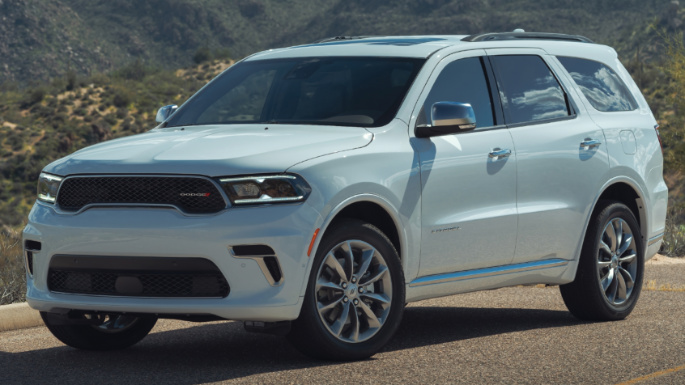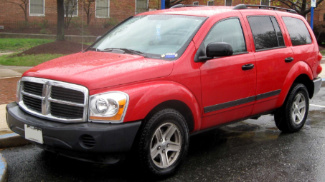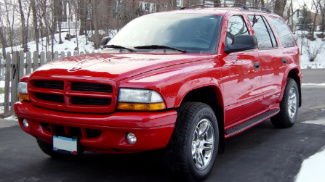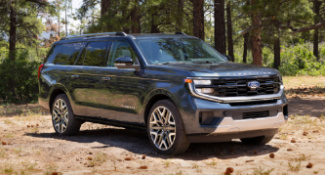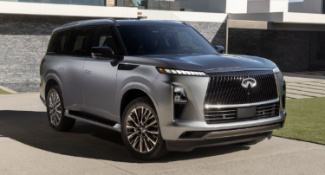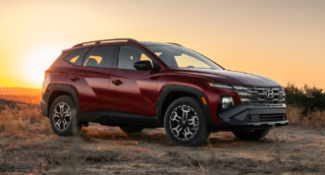The Dodge Durango is a full-size SUV that has been in production since 1998. It is currently in its third generation and offers a wide range of different variants, models, and trim levels. Dodge ceased Durango production after the 2009 model year, but restarted it for the 2011 model year after a full refresh of the vehicle, meaning there was only a one-year gap in production.
2011 – Present (3rd Generation)
Dodge restarted production of the Durango SUV for the 2011 model year, and the third-generation Durango is still in production.
This latest generation Durango has drastically different exterior styling than the previous generation vehicle. Headlights, grille, taillights, and most body panels feature more sculpting and aggressiveness than the square-shouldered look of the second-generation Durango, with cues from the contemporary Dodge Charger. This generation vehicle is slightly shorter and narrower, which results in slightly less interior cargo and passenger space.

For the 2014 model year, Dodge released a face-lifted Durango with more aggressive styling, a few interior tweaks, and an eight-speed automatic transmission. Auto start-stop was introduced in 2016, and the 475-horsepower SRT version was released for the 2018 model year. For the third generation Durango, there are a total of 12 trim levels to choose from, versus the second generation’s five.
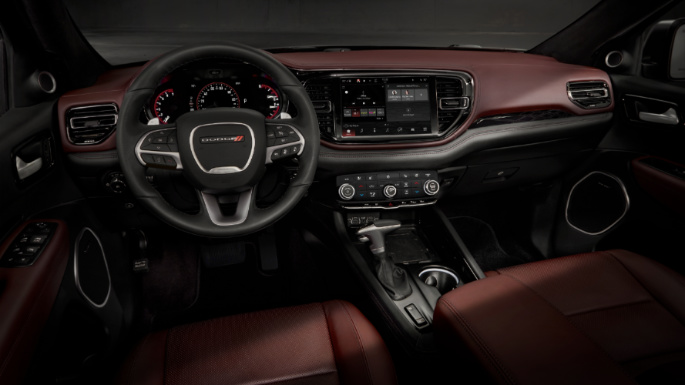
One other significant change Dodge introduced for this model year is the Durango’s underpinnings. It uses the same platform and many of the same parts as the Jeep Grand Cherokee. Previously, the Durango used a separate frame. Other updates included mild changes to the exterior design and interior layout.
In 2018 the Dodge Durango SRT was added to the lineup with a 6.4-liter Hemi engine making 475 horsepower as well as standard all-wheel-drive (AWD), bigger Brembo brakes, and sporty suspension tweaks.
The 2019 Dodge Durango added more available equipment, including standard captain’s chair for the Citadel trim, optional blind-spot monitoring, and an optional working hood scoop for GT models. A trailer brake was added to the Trailer Tow Package.
For the 2021 model year Dodge introduced the massively powerful, track-inspired 2021 Durango SRT Hellcat. The Hellcat moniker was found on all of Dodge’s most potent offerings. The new Durango Hellcat was powered by a supercharged 6.2-liter Hemi Hellcat V8 engine that produced 710 horsepower and 645 pound-feet of torque, making it the most powerful SUV to date. It could make the run to 60 miles per hour in 3.5 seconds and complete the quarter-mile in 11.5 seconds. When it debuted Dodge said the limited edition model would be available for the 2021 model year only.
In 2021 “normal” versions of the Durango also received a refreshed exterior design, revised interior with a larger optional touchscreen, and added a Tow N Go package which allowed for a max towing capacity of 8700 pounds when equipped on Dodge Durango R/T trim models.
In 2022 Dodge shuffled some of the standard equipment across trim packages, largely adding features at each level. Base SXT models received additional safety features, mid-tier trims added niceties like a heated steering wheel in GT models, and top-trim R/T models got Nappa leather, upgraded Harman/Kardon audio, and more. The Dodge Durango SRT Hellcat was not produced for the 2022 model year.
For 2023, Dodge reintroduced the Dodge Durango SRT Hellcat, to some controversy. Previous buyers of the “one year only” model were upset at the potentially diminished collectability of their vehicles, but the demand was too great for Dodge to resist. The speedy Durango also added Plus and Premium trims for even more luxury than the standard model. SRT 392 models added more available paint colors. The standard Durango also added paint options, standard heated seats, and more available safety features for base models.
In 2024 Dodge made blind-spot monitoring standard across trims and opened the Tow N Go package to more trim levels. SRT 392 and SRT Hellcat models are also largely unchanged for the new model year. 2024 is rumored to be the final year for the Dodge Durango nameplate, as Dodge makes way for an all-new model. Some publications however speculate that the Durango may return as a larger more luxurious model to sit atop the Dodge SUV lineup.
2004 – 2009 Dodge Durango (2nd Generation)
The second-generation Durango was a significant departure from the first-generation vehicle, particularly in terms of exterior styling. From 2004 to 2009, the Durango was chunky and squared-off, which perfectly fit the automotive design aesthetic found in many vehicles in the early 2000s.
It was seven inches longer, two inches wider, and three inches taller than the first-gen Durango. It was also significantly larger inside and offered more cargo space (some 15 percent more) and room for passengers.
Under the hood, the Durango offered several different engine choices, many of which evolved over the second generation’s five model years. The Durango was the very first Dodge SUV to use the famous Hemi engine. The base engine was the 210 horsepower Magnum V6, and the range-topping 5.7-liter Hemi V8, which made 376 horsepower and 401 pound-feet of torque, debuted for the 2009 model year. A smaller Hemi engine was also offered.
Towing was significantly improved over the first-generation Durango -- properly equipped, this generation could tow up to 8,900 pounds over the previous maximum of 7,500 pounds.
The second-generation Durango came in five different trim levels – ST, (which was later renamed to ‘SE’), SXT, SLT, Adventurer, and Limited.
This version of Durango also had a new braking system. Dual-stage front airbags were standard equipment, while side curtain airbags were an optional extra.
It was right after the 2009 model year that Dodge made the decision to discontinue the Durango due to slow sales. The Newark Assembly facility in Newark, Delaware, was shuttered in 2008, and production of the Durango and its sister car, the Chrysler Aspen, ended in mid-December 2008.
1998 – 2003 Dodge Durango (1st Generation)
The first-generation Dodge Durango was introduced for the 1998 model year as a replacement for the Dodge Ramcharger. Its exterior styling is noticeably different than its successors – Dodge’s ‘crosshair’ grille is significantly smaller, and its overall shape is simpler, more rounded, and rugged. It shared many parts with other vehicles across the Dodge/Chrysler/Plymouth family at the time. Styling cues from the Dodge Ram, Dodge Dakota, and even the Dodge Caravan minivan were present in the design. An optional third-row seat allowed for up to seven passengers. Though, like many early midsize SUVs with three rows of seating, space in the rear seat was tight for adult passengers. In its first year, the Dodge Durango was sold only with a four-wheel drive powertrain.
There were several improvements and updates made to the Durango over the first few model years. In 1999, a rear-wheel-drive variant was introduced along with the 3.9-liter Magnum V6 engine. It was also around this time that Dodge created a special Shelby SP-360 version of the Durango, which used a supercharged 5.9-liter V8 engine and made 360 horsepower and 412 pound-feet of torque.
One year later, in 2000, a 4.7-liter Magnum V8 engine became available, and Dodge made the decision to discontinue the Magnum V6 altogether and use only V8 engines in the Durango going forward. This year also saw the introduction of the R/T model Durango.
2001 saw minor interior changes and upgrades. In 2003, the SUV received notable safety upgrades including all-wheel disk brakes, in addition to other mechanical and cosmetic changes.
The first-generation Durango’s original exterior dimensions are a wheelbase of 116.2 inches, an overall length of 193.5 inches, a width of 71.3 inches, and a height of 70 inches. Those numbers varied slightly over its production run but remained very similar. The curb weight was a hefty 4,689 pounds.
The body-on-frame architecture of the early Durango was based on the Dakota pickup truck. Dodge tried to position the Durango above smaller SUVs of the time like the Chevrolet Blazer and Ford Explorer, but a step down from the larger Chevrolet Tahoe.
